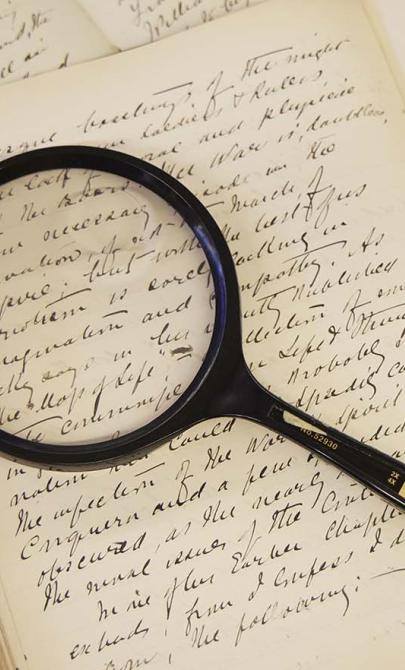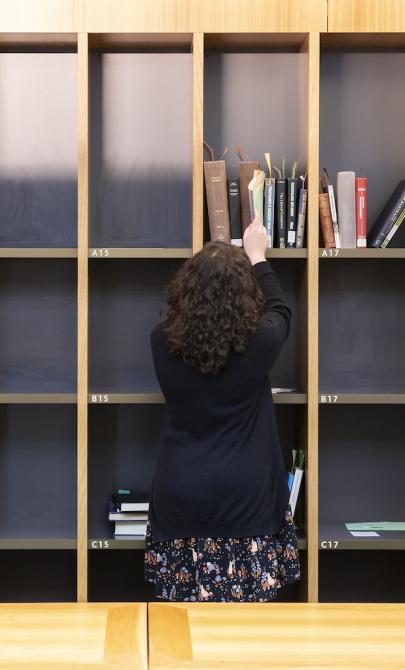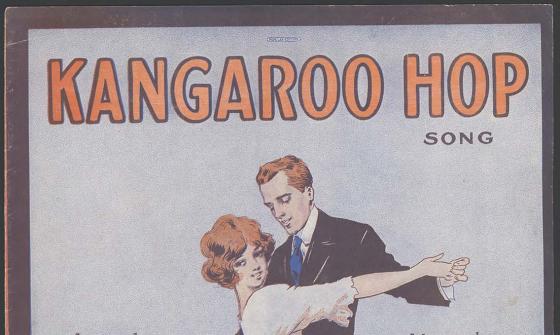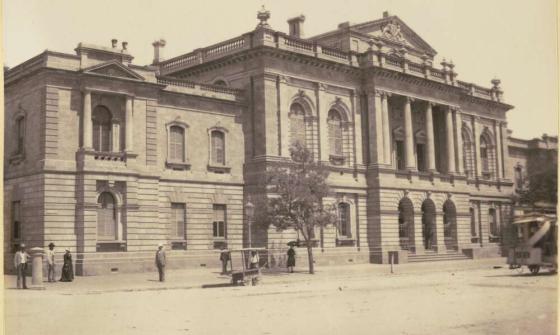Anti-slavery movement in the United States
Key items in the collection
This collection hosts a range of formats, including:
American Colonization Society (mfm 1062)
The American Colonization Society was set up in 1817 to create a colony in West Africa for former American slaves. They established Liberia in 1824, where over 13,000 people eventually settled. The Society aimed to stay neutral on the issue of slavery but was criticized by many abolitionists as being pro-slavery.
There are 323 reels of microfilm with records from the American Colonization Society, mostly from 1823 to 1912, organised into:
- Incoming letters (1819-1917) - 181 reels
- Outgoing letters (1839-1912) - 61 reels
- General correspondence (1909-1965) - 8 reels
- Financial documents (1818-1963) - 35 reels
- Business papers (1816-1963) - 14 reels
- Subject files (1792-1964) - 16 reels
- Various other documents (1835-1935) - 8 reels
British and Foreign Anti-Slavery Society (mfm 889)
The British and Foreign Anti-Slavery Society, founded in 1839, was deeply involved in the fight against American slavery and organised two major World Anti-Slavery Conventions in London. While it worked closely with American abolitionists, it did not always agree with their strategies.
The Society’s records are available on two reels of microfilm, which include:
- Minute books (1839-1868)
- Memorials and petitions (1839-1850)
- Incoming letters (1836-1862)
John B. Estlin and his daughter, Mary Estlin, were active supporters of the anti-slavery movement in England. Mary corresponded with well-known American abolitionists like William Lloyd Garrison and Harriet Beecher Stowe and even visited the U.S. in 1868.
The Estlin Papers collection has six reels of microfilm, which include:
- A minute book from the Bristol and Clifton Auxiliary Ladies Anti-Slavery Society (1840-1860)
- Letters written to Mary Estlin, including those from her 1868 trip to America
- Pamphlets and reports on the anti-slavery movement and the Civil War
Oberlin College in Ohio was a hub for the abolitionist movement from its founding in 1833. It was one of the first colleges to admit both African-American students and women, and it played a role in the Underground Railroad, helping enslaved people escape to freedom.
This collection includes around 2,500 books and pamphlets from 1780 to 1865, featuring speeches, slave narratives, anti-slavery society reports, and writings from notable figures like Frederick Douglass, Harriet Beecher Stowe, and Abraham Lincoln.
Slavery: Source Material and Critical Literature (mc 104)
This large microfiche collection covers works on slavery from around 1740 to 1940, including many documents from the years after the American Civil War. It features speeches, sermons, slave narratives, travel accounts, songs, poems, and more.
The collection highlights publications from the U.S., but also includes works from Britain, France, Germany, and Spain. Notable authors in this collection include Frederick Douglass, Abraham Lincoln, William Lloyd Garrison, and many others.
These collections are valuable resources for anyone researching the history of slavery, abolition, and the fight for freedom across different parts of the world.
Collections of documents
- John W. Blassingame, ed., The Frederick Douglass papers, 5 vols, 1979-92
- Philip S. Foner and Herbert Shapiro, eds, Northern labor and antislavery : a documentary history, 1990
- Walter M. Merrill, ed., The letters of William Lloyd Garrison, 6 vols, 1971-81
- Truman Nelson, Documents of upheaval; selections from William Lloyd Garrison's the Liberator, 1831-1865, 1966
- William H. Pearse and Jane H. Pearse, eds, The antislavery argument, 1965
- Wendell Phillips, Speeches, lectures, letters, 1864
- Louis Ruchames, ed., The abolitionists; a collection of their writing, 1963
Historical studies
- Robert H. Abzug, Passionate liberator : Theodore Dwight Weld and the dilemma of reform, 1980
- Herbert Aptheker, Abolitionism: a revolutionary movement, 1989
- Gilbert Barnes, The antislavery impulse, 1830-1844, 1933 [new ed. 1964]
- Fergus M. Bordewich, Bound for Canaan: the underground railway and the war for the soul of America, 2005
- Richard O. Curry, ed., The abolitionists, 1973
- Martin Duberman, ed., The antislavery vanguard: new essays on the abolitionists, 1965
- Dwight L. Dumond, Antislavery: the crusade for freedom in America, 1961
- Louis Filler, The crusade against slavery, 1830-1860, 1960
- Carleton Mabee, Black freedom: the nonviolent abolitionists from 1830 through the Civil War, 1970
- William S. McFeely, Frederick Douglass, 1991
- John R. McKivigan, The war against proslavery religion: abolitionism and the northern churches, 1830-1865, 1984
- Henry Mayer, All on fire: William Lloyd Garrison and the abolition of slavery, 1998
- Jane H. Pease and William H. Pease, Bound with them in chains: a biographical history of the antislavery movement, 1972
- Lewis Perry, Radical abolitionism: anarchy and the government of God in antislavery thought, 1973
- Lewis Perry and Michael Fellman, eds, Antislavery reconsidered: new perspectives on the abolitionists, 1979
- Benjamin Quarles, Black abolitionists, 1969
- Loman Ratner, Powder keg: Northern opposition to the antislavery movement, 1831-1840, 1968
- David S. Reynolds, John Brown, abolitionist: the man who killed slavery, sparked the Civil War, and seeded civil rights, 2005
- Leonard L. Richards, Gentlemen of property and standing: anti-abolition mobs in Jacksonian America, 1970
- W. Sherman Savage, The controversy over the distribution of abolition literature, 1830-1860, 1968
- Richard H. Sewell, Ballots for freedom: antislavery politics in the United States, 1837-1860, 1976
- James B. Stewart, Holy warriors: the abolitionists and American slavery, 1976
- James B. Stewart, Wendell Phillips, liberty’s hero, 1986
- Ronald G. Walters, The antislavery appeal: American abolitionism after 1830, 1976
- Bertram Wyatt-Brown, Lewis Tappan and the evangelical war against slavery, 1969
- Bertram Wyatt-Brown, Yankee saints and Southern sinners, 1985
- Jean Fagan Yellin, Women & sisters: the antislavery feminists in American culture, 1989
About the anti-slavery movement in America
Before 1833, the anti-slavery movement in America was mostly unorganised, with only a few local groups taking action. Some early societies include the New York City Manumission Society (founded in 1785) and the Pennsylvania Abolition Society (founded in 1789).
The first national effort was the American Colonization Society, established in 1817. Led by influential men from the upper South and supported by the Federal Government, this society focused on creating a colony in western Africa (Liberia) for freed slaves. Despite facing opposition from abolitionists, the society succeeded in helping over 10,000 people settle in Liberia by 1865.
Rise of organised abolitionist movements
The abolitionist movement gained momentum in 1831 when William Lloyd Garrison of Massachusetts founded the newspaper The Liberator. A year later, he established the New England Anti-Slavery Society. In 1833, Garrison teamed up with Arthur and Lewis Tappan from New York to create the American Anti-Slavery Society. This society quickly grew, reaching 1,350 local chapters and about 250,000 members within five years. During this time, there was a surge in the production of abolitionist pamphlets, tracts, newspapers, and petitions.
However, the society split in 1839 due to internal disagreements. Garrison and his followers alienated more moderate members by criticising churches, opposing political involvement, denouncing the Constitution for supporting slavery, and advocating for women to hold positions within the organisation. This led Lewis Tappan to form the American and Foreign Anti-Slavery Society, while the Liberty Party was also established, with James Birney running as its presidential candidate in 1840 and 1844.
Evolution into political movements
Initially, many abolitionists hoped that the major political parties, the Democrats or Whigs, would adopt stronger anti-slavery positions. When that didn't happen, former members of both parties formed the Free Soil Party in 1848, which managed to send two senators and 14 representatives to Congress. By 1854, the Free Soil Party joined forces with Whigs who opposed slavery's expansion into Kansas, leading to the creation of the Republican Party, which gained significant power when Abraham Lincoln was elected president in 1860.
The religious roots of abolitionism
Historian Richard Hofstadter described abolitionism as a religious movement that emerged from the evangelical Protestant revival in the Northern United States. He noted that it was closely linked to other reforms of the time, like women's rights, temperance, and pacifism. The movement’s approach was similar to that of religious revivals, using church congregations to spread its message and inspire action.
Abolitionist publications and their impact
A key element of the movement was the publication of anti-slavery literature, which played a significant role in spreading the abolitionist message. Books, newspapers, pamphlets, speeches, and reports were widely distributed, despite efforts by Southern states to block them. One notable example is Theodore Weld's American Slavery As It Is: Testimony of a Thousand Witnesses (1839), which sold nearly 100,000 copies in its first year.
Abolitionist newspapers like The Liberator, The Emancipator, Slaves’ Friend, and Anti-Slavery Record had massive circulation numbers, with over a million copies printed in 1835 alone. These publications were vital in raising awareness and rallying support for the cause in the Northern states.
Background to the collection
We have 5 microform collections that focus on the history of the anti-slavery movement. These collections were gathered between 1969 and 1984. You'll also find a range of other materials, like books and historical documents, that offer more insights into this topic.
We have several collections related to the anti-slavery movement available on microfilm, microcards, and microfiche. Here's a breakdown of what's available:
- American Colonization Society: This collection has 323 reels of microfilm (mfm 1062). You can find a detailed list of its contents in a 34-page register published by the Library of Congress in 1979.
- British and Foreign Anti-Slavery Society: There are two reels of records (mfm 889), with a list of what's included at the start of each reel.
- Eslin Papers: This set includes six reels of microfilm (mfm 893), and each reel begins with a description of its contents.
- Oberlin College Library collection: Filmed on about 7,500 microcards (mc 13), this collection is organised alphabetically by author or title. You can also use a finding aid published by the Lost Cause Press in 1968 to locate specific items.
- Slavery: source material and critical literature: This collection has around 9,500 microfiche (mc 104). While about 1,070 titles are listed in the online catalogue, the rest have catalogue cards available in the Main Reading Room.
Books related to these collections can be found in the General Collection at various library locations.
This guide was prepared using these references:
- American Colonization Society: a register of its records in the Library of Congress Manuscript Division, Washington, Library of Congress, 1979
- Dwight L. Dumond, A bibliography of antislavery in America, Ann Arbor, University of Michigan Press, 1961
- Richard Hofstadter, The American political tradition and the men who made it, New York, A.A. Knopf, 1948
- Lost Cause Press, Anti-slavery propaganda in the Oberlin College Library, Louisville, Lost Cause Press, 1968
First posted 2008 (revised 2019 and 2024)







